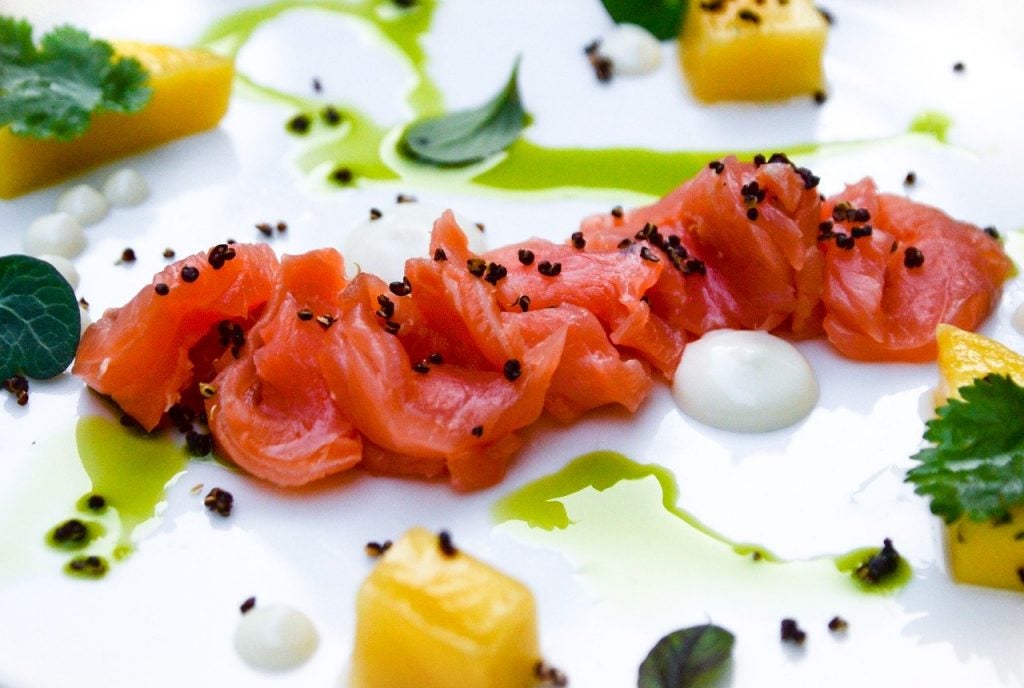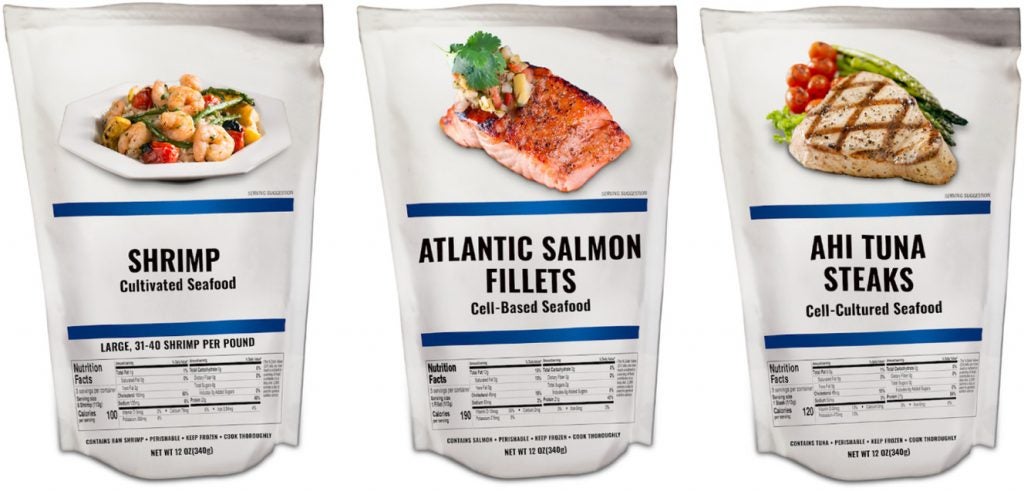Cell-based, cultured… or something else? The new seafood labeling challenge.
 By Tom Neltner, J.D., Environmental Defense Fund Chemicals policy director
By Tom Neltner, J.D., Environmental Defense Fund Chemicals policy director
Meat and seafood derived from animal cells grown outside the animal are likely coming to your kitchen table. The process involves culturing cells in tanks and combining them into a consumable product using extrusion, 3-D printing or other processes commonly used in food industry. The product is nearly identical to conventional meat and seafood.
But when consumers can make that choice depends on the scaling-up of the technology and securing regulatory approvals. Beyond ensuring these products are safe, a key issue is finding a name for them that does not mislead consumers — enabling them to make informed choices about what they are buying. We have seen marketing studies favor “cultivated meat” and government reports use “cell-cultured meat,” but they lack sufficient scientific rigor to meet the labeling need. Here, we discuss a recent study covering this newfound seafood labeling challenge.
In July, a peer-reviewed study by Rutgers University researchers, William Hallman and his son, helped advance the discussion on the appropriate name for seafood. The study, which included more than 3,000 adult participants, found that the term “cell-based” was most appropriate for seafood grown outside the animal, with “cell-cultured” a close second. “Cultivated” without the word “cell” was found to be misleading since 54% of consumers incorrectly thought the seafood was farm-raised. Because the analysis was funded by BlueNalu — a start-up adapting the innovative technology to produce seafood, which is currently ahead in the race to reach the market — we were concerned it might be biased, but a close review showed a solid analysis.
The study also revealed that even with the top two terms, many consumers were still confused, emphasizing the need for consistent consumer education — in labeling and marketing — from the companies. For that reason, we were pleased to see the U.S. Food and Drug Administration and Department of Agriculture announce they were jointly developing labeling principles for meat and seafood that would provide the needed consistency.
FDA labeling requirements
Seafood labeling is particularly critical because seafood is a major food allergen. While the product may be grown outside the animal, it still poses a risk to consumers with fish or seafood allergies. Therefore, federal law requires packaging to identify the species of fish or shellfish.
In addition, FDA regulations require that the name accurately describe, in as simple and direct terms as possible, the basic nature of the food and not be confusingly similar to another food. In particular, the name for seafood grown outside of an animal must clearly differentiate itself from wild-caught or farm-raised seafood.
To date, the FDA and USDA (which has complementing labeling jurisdiction for names of most meat) have not provided guidance on the most appropriate labeling term. However, based on statements made in a recent webinar, we expect guidance to come later this year. The Hallmans’ study should be useful for the agencies.
Label options considered
The study authors reviewed the literature, internet searches and consumer studies and settled on seven options to describe seafood grown outside the animal ranging from cell-based to cultured to cultivated, to more detailed options such as “Grown Directly from the Cells of ___.” They did not consider options such as “synthetic meat” or “cruelty-free meat” because the former was seen as inaccurate and the latter as derogatory to conventional meat, and therefore wouldn’t meet legal labeling requirements.
The study compared seven options for seafood grown outside the animal to three others: “wild-caught,” “farm-raised” and simply the name of the seafood (with no descriptor) as a control. For the basic seafood name, the study used salmon, tuna and shrimp since they represent 55% of all seafood consumed in the U.S.

Survey method
The survey used high-quality images of the front of packages as in Figure 1. The nutrition facts panel was the same for all 10 options presented (seven descriptors for seafood grown outside the animal, wild-caught, farm-raised and none). Hallman recruited 3,186 participants in February and March 2020 from a web-based consumer panel with more than 3.2 million active members. The authors selected them to produce a nationally representative sample of adults based on responses to email invitations to 8,845 randomly-selected panel members and a follow-up questionnaire.
Survey participants were first given a definition of seafood that included both fish, shellfish and crustaceans. They were asked how often they had eaten seafood in the previous year and then repeatedly shown only one of the 30 images (3 species of seafood and 10 options of each). Only at the end were participants given a definition of cell-based seafood and asked some final questions.[1] Almost a third were moderately, very or extremely familiar with the idea of producing just the parts of the seafood that people eat instead of catching or raising them whole.
Distinguishing from wild-caught and farm-raised
When the label used the words “Wild-Caught” or “Farm-Raised” to describe how the seafood was raised, about 90% of consumers correctly identified it, meaning about 10% of participants got it wrong. This result marks the best we can expect from any description. In contrast, when no description was given, 53% said the seafood was neither wild-caught or farm raised; this represents the minimum we should expect any description should achieve. Falling significantly below 53% means the description is misleading.
When consumers were given a label with one of the seven options for seafood grown outside the animal and tested to see if they could distinguish them from wild-caught or farm-raised, Hallman found that the results fell into three groups:
- Best Scores: “Cultivated from the Cells of” with 61%; “Cell-Based” with 58%; “Cell-Cultured” with 55%; and “Grown Directly from the Cells of” with 54%. Between 17% and 20% thought these descriptions referred to wild-caught seafood and 22-29% thought the seafood was farm-raised. They fared 1 to 8 percentage points better than a label with no description.
- Weak Scores: “Cultured” without the word “cell” with 41% and “Produced Using Cellular Aquaculture” with 40%. They created more confusion than a label without any description of how the seafood was raised.
- Worst Score: “Cultivated” without the word “cell” scored worst among the seven, with 54% of consumers thinking it was farm-raised and only 30% realizing it was neither wild-caught or farm-raised.
Consumer acceptance
Hallman also evaluated whether any of the options were disparaging to a product or evoked responses inconsistent with the products being safe, healthful and nutritious. These were indicators of consumer acceptance. The authors found the following:
- Initial positive or negative reactions: All options were seen as slightly positive. Of the four best-scoring options above, “Cell-Based” had no difference from “Farm-Raised” or “Wild-Caught.”
- Overall positive or negative reactions: All options were seen as slightly positive. Two of the best-scoring options above, “Cell-Based” and “Cell-Cultured,” had no difference from “Farm-Raised” but were lower than “Wild-Caught.”
- Safe to eat: All options were seen as safe to eat to people not allergic to the species. Three of the best-scoring options above, “Cell-Based,” “Cell-Cultured” and “Grown Directly from the Cells of,” had no difference from “Farm-Raised.” All of these options were seen as less safe than “Wild-Caught.”
- Nutritious: All options were seen as moderately nutritious. Two of the best-scoring options above, “Cell-Based” and “Grown Directly from the Cells of” had no difference from “Farm-Raised” or “Wild-Caught.”
- Taste: All options were seen as slightly good with participants moderately interested in tasting them and likely to buy in the next six months. Of the four best-scoring options, “Cell-Based” had no difference from “Farm-Raised” or “Wild-Caught.”
“Cell-based” favored over “Cell-cultured”
The Hallman study concluded that of the four best-scoring options, “Cell-Based” followed by “Cell-Cultured” fared best on consumer acceptance measures. The authors acknowledged that more study was needed to differentiate the two descriptions and indicated they would be conducting a follow-up study to evaluate the two options in more detail.
The problem with “Cultivated” on its own
Describing seafood grown outside the animal as “Cultivated” scored worst of the seven options in helping consumers distinguish it from “Wild-Caught” and “Farm-Raised,” with 30% of consumers getting it right — well below the 53% with the label that provided no description on how the seafood was raised. More than half of consumers thought the seafood was farm-raised. Given this confusion, not surprisingly, it scored well on consumer acceptance — consistently rating no different than farm-raised seafood.
In contrast, when the description was “Cultivated from the Cells of ___,” there was less confusion. It scored best among the seven options, with 61% getting it right. But, it had the lowest ratings in most of the other factors, with the lowest positive reaction, lowest perception of safety, nutrition and taste. Adding the word “cell” appears to significantly change consumer perceptions.
The study saw a similar, but not as dramatic, difference between “Cultured” and “Cell-Cultured.” From this, we think the word “Cell” in the name is essential to avoid confusion.
Conclusion
The Hallman study is significant because it followed a robust scientific process. Based on the analysis, we think the most appropriate terms are “cell-based” or “cell-cultured” meat or seafood, while the term “cultivated” without the word “cell” is misleading. A similar thorough analysis should be done for other types of meats.
Though, one note of caution: even the best-scoring option was still commonly confused with farm-raised and wild-caught seafood. Hopefully this result will improve with greater consumer education, but that education must be consistent and scientifically-based rather than focused on marketing opportunities. If food producers use different terms, then it will likely create more confusion in the marketplace and undermine consumers’ trust in the innovative foods. Therefore, it is important for the FDA and USDA to provide clear guidance to the producers.
[1] For salmon, participants were told: “The term Cell-based Seafood indicates that this salmon differs from both wild-caught and farmed salmon. It tastes, looks, and cooks the same and has the same nutritious qualities as Atlantic Salmon produced in traditional ways. Yet, it involves a new way of producing just the parts of Salmon that people eat, instead of catching or raising them whole. Cell-based Seafood means a small number of cells from Atlantic Salmon were placed in a nutrient solution, where they grew and reproduced many times. The resulting meat was then formed into fillets that can be cooked or eaten raw.”












